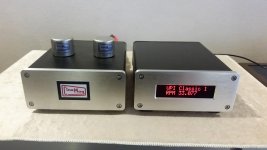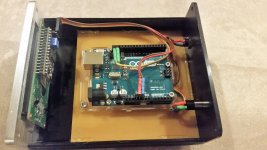Jorge could you make one for me please?
TIA
Felipe
Ok. No problem.
Hablamos por privado...
Cheers,
Jorge
At last! its completed. Looking forward to SG-4 in January 2018.
Attachments
Last edited:
That's the best looking tachometer I've seen to date.
What kind of display is that? Did you use a neutral density window in front of it?
Classic 1 table? You should post pics on VPI's forum....
What kind of display is that? Did you use a neutral density window in front of it?
Classic 1 table? You should post pics on VPI's forum....
Bill, Thank you very much for your kind praise. I'm very proud of my achievement and posted a picture of it on Facebook "I love my VPI turntable" group.
The display I used is a Midas MC21605G12W-VNMLR http://www.newark.com/midas/mc21605g12w-vnmlr/lcd-alpha-num-16-x-2-red/dp/52Y1050 Its a high quality display compared to the common and affordable China made LCD modules that I used during the course of construction and learning all about how it all tick. I was having 2 different displays that seemed similar, 2 different I2C modules that also look the same but they're not, learning what makes it tick and getting them to work. This involved changing hardware parameters in the code and modding the I2C to suit. It all worked out later on.
I didn't use anything on it and just glued the display module to the panel. I've found the display to be quite easy on the eye and have always liked red characters. I had to mod the LCD pin out to piggy back a common I2C module for serial connection for it to work. Its been a great learning curve with no past experience with any Arduino, LCD modules or programming these stuff.
Here's a picture of the innards. I bolted the Arduino to a blank piece of pcb and slide into the enclosure. The DC power and sensor wires are soldered to the underside. I only have to remove the front panel for USB connection if need to program.
The display I used is a Midas MC21605G12W-VNMLR http://www.newark.com/midas/mc21605g12w-vnmlr/lcd-alpha-num-16-x-2-red/dp/52Y1050 Its a high quality display compared to the common and affordable China made LCD modules that I used during the course of construction and learning all about how it all tick. I was having 2 different displays that seemed similar, 2 different I2C modules that also look the same but they're not, learning what makes it tick and getting them to work. This involved changing hardware parameters in the code and modding the I2C to suit. It all worked out later on.
I didn't use anything on it and just glued the display module to the panel. I've found the display to be quite easy on the eye and have always liked red characters. I had to mod the LCD pin out to piggy back a common I2C module for serial connection for it to work. Its been a great learning curve with no past experience with any Arduino, LCD modules or programming these stuff.
Here's a picture of the innards. I bolted the Arduino to a blank piece of pcb and slide into the enclosure. The DC power and sensor wires are soldered to the underside. I only have to remove the front panel for USB connection if need to program.
Attachments
Last edited:
Nice work indeed, coolmaster! Giving me more ideas for boxing mine up so that I don't have the mess of wires sitting next to my motor. 😛
Maybe at later time, I will also solder the LCD wires to the Arduino underside, will look cleaner at the top side.
I would adjust for 33.333 in the middle of the record with needle down.
I'd buy a better turntable with a more powerful motor and less belt slip.
I'd buy a better turntable with a more powerful motor and less belt slip.
Hi,
I’m afraid I can not afford buying a better turntable.
I think I have a nice one already, a heavily modified Rega, with a 24 volts motor, better than the original 110 one. Also, I have a three belt pulley from Michael Lim with a machined aluminium subplatter and an acrylic platter, so I think there is little to no belt slip.
Regards,
Jorge
The (very small) change in speed with stylus drag is most likely caused by a minuscule amount of belt creep instead of slippage. Slippage can be cured with proper tension, belt creep cannot, and it wouldn't matter how powerful the motor was, the belt would still creep.
The (very small) change in speed with stylus drag is most likely caused by a minuscule amount of belt creep instead of slippage. Slippage can be cured with proper tension, belt creep cannot, and it wouldn't matter how powerful the motor was, the belt would still creep.
Trying to understand belt creep - would you say it is the function of the (1) pulley design or (2) belt composition/structure (elasticity/rigidity) or (3) something else?
Tension should be relatively easy to implement with a separate motor pod (or a tensioning mechanism such as the one with Artemis), but how would one cure belt creep?
I own a VPI Classic 1 with 20lb platter and stock 10W Hurst Motor, no speed controller.
I experimented with a DIY clear color PU (Polyurethane) belt of the same diameter spliced to the same circumference for experimentation. No creep (hardly noticible if any). Tension and elasticity is different from the original rubber belt. I don't find any significant speed variance between the 2 types expect the slight creep on the rubber belt. I don't find any stylus drag issue. Even if any which I can't see on the tachometer, I'll live with it.
I experimented with a DIY clear color PU (Polyurethane) belt of the same diameter spliced to the same circumference for experimentation. No creep (hardly noticible if any). Tension and elasticity is different from the original rubber belt. I don't find any significant speed variance between the 2 types expect the slight creep on the rubber belt. I don't find any stylus drag issue. Even if any which I can't see on the tachometer, I'll live with it.
I use digital pin 2 to calibrate the timer routine. The constant CALIBRATE (used to compute the RPM value) should be the frequency at pin 2 x 120. It could be disabled and the code commented out, but it is a handy way to see if the timer ISR is working properly and to calibrate the reading.
Might have missed this - would this mean that the proper way to calibrate for each Arduino (given crystal discrepancies) would be to measure the frequency at this pin and thus set the CALIBRATE const?
Trying to understand belt creep - would you say it is the function of the (1) pulley design or (2) belt composition/structure (elasticity/rigidity) or (3) something else?
Tension should be relatively easy to implement with a separate motor pod (or a tensioning mechanism such as the one with Artemis), but how would one cure belt creep?
There is a good explanation of it Here.
It is a function of torque and belt composition. When the platter is up to speed, the amount of torque being delivered is very low; it increases microscopically with stylus drag, so you see a microscopic decrease in speed.
Might have missed this - would this mean that the proper way to calibrate for each Arduino (given crystal discrepancies) would be to measure the frequency at this pin and thus set the CALIBRATE const?
That will give you the most accurate result.
- Home
- Source & Line
- Analogue Source
- Digital Tachometer for record player (LCD display)

